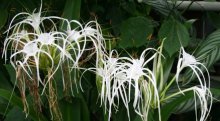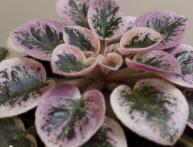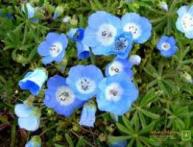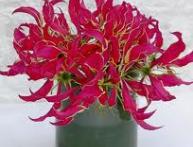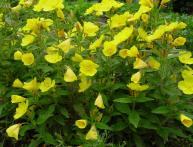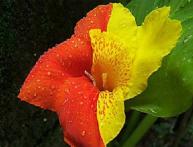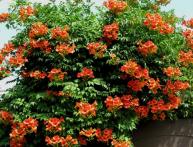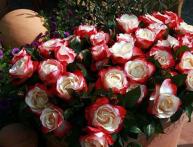Ismena flower - elegant bells for a windowsill, garden or greenhouse
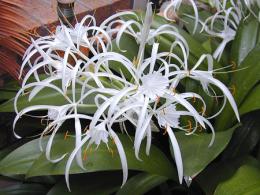
Ismene is a beautiful and delicate flower with an original inflorescence shape. Other names: hymenocallis, spider lily, Peruvian narcissus. This plant can be grown on a windowsill, in open ground, in winter gardens and greenhouses.
Content:
- Flower ismene (ismene)
- Growing on a windowsill. Growing in the garden
- Bulb germination and propagation
Flower ismene (ismene)
Ismena is a fairly tall flower and can sometimes reach 80 cm. The leaves are large, up to 50 cm long. The color is bright green. The plant produces several flower stalks, about 60 cm high. At the end of each stalk, from 3 to 6 fragrant flowers are formed. The shape of the flowers resembles a wild lily, but inside they are similar to a daffodil.
There is a gramophone in the center, and along the outer edge there are long curled petals. The middle of the gramophone has green veins. Most often the flowers are white, but there are varieties with cream, yellow and multi-colored inflorescences. You can also find ismene, which changes color as it blooms from white to cream. Some varieties have purple, pink or yellow spots on the petals.
Depending on the variety, flowering can be amicable or alternate. In open ground, the plant blooms even in cool or cloudy summers. Planting is most often done with bulbs. If the bulb is mature, then already at the beginning of summer the plant produces flower stalks. Daughter bulbs bloom in the 3rd year.The buds are connected to each other by a film shell, which breaks as they grow, allowing the flowers to move apart in different directions.
Each blooming flower can reach up to 15 cm in diameter. When blooming together, a fairly large and beautiful ball is formed at the end of the arrow. Some varieties, for example Sufur, are distinguished by alternate opening, the period of which can last up to 3 weeks.
The plant, thanks to its large leaves, is beautiful and decorative even without flowers. In autumn the leaves turn yellow and the plant is put away for winter dormancy. The bulbs are dug up or left in the ground, depending on the growing method.
Growing on a windowsill. Growing in the garden
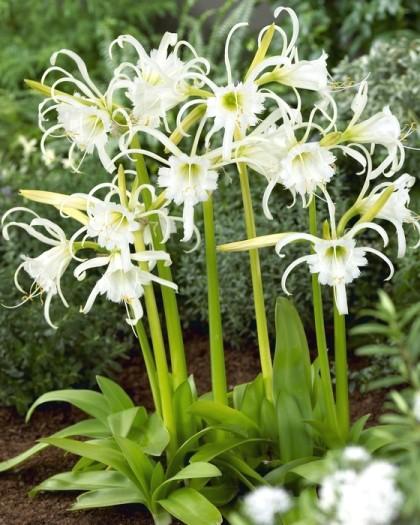
Growing ismene indoors is not difficult. For the flower, choose a spacious pot, fill it with turf soil with the addition of peat and a small amount of sand. Be sure to have drainage and good holes in the bottom. Water stagnation is unacceptable when caring for bulbous flowers.
Planting a bulb to a depth of about 5 cm. Ismene loves well-lit places, but is afraid of direct sunlight. Grows well at temperatures of 18-25 degrees. During the rest period, the pot is placed in a dark room, the temperature of which is from 10 to 14 degrees. Sometimes, the leaves do not die, then the temperature is gradually reduced, which provokes yellowing of the foliage and the flower going to rest. During the dormant period, fertilizing and watering are completely stopped.
In mid-February, the pot is returned to the windowsill. The bulb will quickly respond to heat, watering and light. Green leaves may appear within a week. Once the growth reaches 5-10 cm, you can apply the first mineral supplement. The plant especially needs additional nutrition during flowering.It is also important that the soil does not dry out and is always slightly moist. After flowering stops, closer to autumn, watering is done less frequently and the plant is prepared for rest. In October they stop completely.
Despite the simplicity of agricultural technology, some gardeners consider the plant capricious and cannot create favorable conditions for it. It often happens that a plant pleases with abundant flowering in the first year, and in subsequent years only leaves form on it.
Growing in the garden
In open ground, ismena is grown only in well-lit places with fertile soil. Acidic, clayey soils with stagnant water are not suitable. The bulbs are lightly moistened with water and left in a warm place to stimulate bud growth. But it’s better to germinate it specifically. Then, if planted in May and properly cared for, Ismena can bloom as early as the end of June.
There are 2 types of cultivation practiced:
- Directly in the open ground
- In containers
- In open ground, the bulbs are planted in a hole to a depth of 3-5 cm. To prepare suitable soil, add a little humus and always river sand. The grounded bulb is watered and sprinkled with dry soil on top to prevent a crust from forming. If the nights are cool, then until germination the plant can be covered with a plastic bottle, jar or just cardboard. After germination, sufficient but moderate watering is important. With a lack of moisture, the leaves become smaller, become flaccid, and lose their elasticity. They feed the spring a couple of times a month, alternating universal mineral fertilizers for flower crops with mullein. Watering and fertilizing are carried out only until the end of flowering. In September, the bulbs are dug up and placed in a box, sprinkled with peat. Store in the basement until spring.Sometimes the peat is lightly sprinkled to prevent the bulbs from drying out.
- Growing in containers used for earlier flowering. Planting takes place in March. The bulbs are planted so that the tip is at ground level. The containers are kept on the windowsill and cared for, similar to the indoor method. When the weather warms up, the plants are taken out into the garden. Most often at the end of May it pleases with flowering. In order to make flowering last longer, you can plant the bulbs alternately at intervals of a week. At the end of the season, you can put the plant away for rest immediately in a container, or dig up the bulbs and prepare them for storage in the basement. After flowering, boxes with seeds are formed, which it is advisable to remove immediately.
Bulb germination and propagation
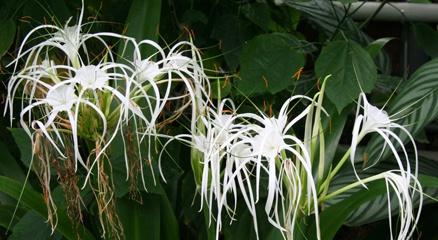
- To germinate, the bulbs are transferred to a warm place with a temperature of 15 to 20 degrees
- If they are sprinkled with peat, sawdust or sand, then the soil is moistened
- If the bulb has just been purchased, then it is placed in a shallow box and covered with peat to the middle.
- This germination helps the buds to wake up and speeds up the appearance of flower stalks.
Ismena can be propagated both seeds and bulbs. Propagation by seeds takes quite a long time and good flowering can only be achieved in the 5th year at best. It is more rational to use the method of propagation by daughter bulbs.
Under no circumstances should bulbs be divided in the fall, otherwise they will not survive the winter. The bulbs are laid for the winter together with the children, who receive the necessary nutrition for better preservation. In spring, the bulbs are separated immediately after being transported to a warm place. Germination is carried out similarly to adults; they are planted, alternating children with mature bulbs.
Fertilizing and watering are done in the same way.With this method, Ismena will delight you with flowering for the 3rd year. It happens that children do not appear on an adult bulb for several years, then you can divide it into several parts and plant it in prepared soil.
For propagation by seeds, they are soaked in a small amount of water. Sow in prepared soil to a depth of 0.5 cm and grow on a windowsill. In 3-4 months, small bulbs appear from the seeds. Every year they are planted, cared for and sent to rest. All flower growers endure a long period of waiting for flowering, so this method is not very successful.
Ismene is a worthy plant for the home, garden or greenhouse. Beautiful, mesmerizing flowers can be used in individual plantings or combined in flower beds with other garden plants. There are also varieties that, in addition to charming flowers, have a wonderful smell similar to vanilla.
A short video about the beautiful Ismena flower:
Interesting information about the vegetable garden


